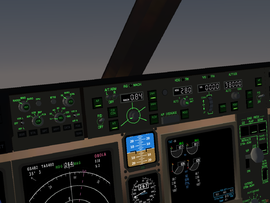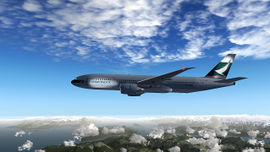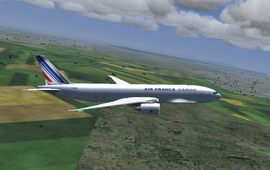Boeing 777
 | |
|---|---|
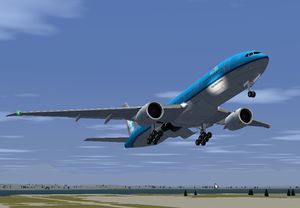 | |
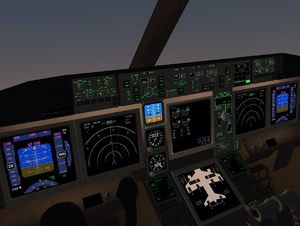 The 3D cockpit of a 777-300 | |
| Type | Airliner |
| Configuration | Wide-body aircraft, Monoplane aircraft, Low wing aircraft, Retractable gear aircraft, Tricycle landing gear aircraft |
| Propulsion | Twinjet (Jet aircraft, Twin-engine aircraft) |
| Manufacturer | Boeing |
| Author(s) |
|
| FDM | YASim |
| --aircraft= |
777-200 777-200-fo 777-200ER 777-200ER-fo 777-200F 777-200F-fo 777-200LR 777-200LR-fo 777-300 777-300-fo 777-300ER |
| Status | Production |
| FDM |
|
| Systems |
|
| Cockpit |
|
| Model |
|
| Development | |
| Website |
|
| Repository |
|
| Download |
|
| Forum |
|
| License | GPLv2+ |
|
| |
| There is a category with screenshots of the Boeing 777. |
The Boeing 777 is a long-range, wide-body twin-engine airliner built by Boeing Commercial Airplanes. The world's largest twinjet and commonly referred to as the "Triple Seven", it can carry between 283 and 368 passengers in a three-class configuration and has a range from 5,235 to 9,450 nautical miles (9,695 to 17,500 km). Distinguishing features of the 777 include the six wheels on each main landing gear, its circular fuselage cross section, the largest diameter turbofan engines of any aircraft, the pronounced "neck" aft of the flight deck, and the blade-like tail cone.
As of May 2008, 56 customers have placed orders for 1,080 777s. Direct market competitors to the 777 are the Airbus A330-300, A340, and some variants of the A350 XWB.
Systems
The Boeing 777 is an advanced fly-by-wire aircraft, and the systems are moderately complicated.
Brief Overview
The video below is a brief introduction of the Boeing 777's new system of the new Seattle Project working with FlightGear Version 3.2 Test Release.
From the forum :
"For anyone who might be interested, our discord server for 777 development is now open to everyone - both developers and flyers! You're welcomed to discuss everything about this craft in this server, including posting screenshots, reporting bugs, posting suggestions for development, or contributing directly to this plane here." Discord Channel
Controls
The Boeing 777 series are fly-by-wire aircraft and like all Boeing aircraft have yokes. The signals are sent electrically to the hydraulic actuators which move the control surfaces. The fly-by-wire system has been simulated within the limitations of YAsim.
- Roll Control Law with attitude holding and bank angle protection
- C*U Pitch Law and Trim Ref function with Flare Mode and Autotrim
- Rudder Ratio, Yaw Damper and Turn Coordinator
Engines
| This section is a stub. You can help the wiki by expanding it. |
| Model | 777-200 | 777-200ER | 777-200LR | 777F | 777-300 | 777-300ER |
|---|---|---|---|---|---|---|
| Engines (Turbofans) | PW 4077 RR 877 GE90-77B | PW 4090 RR 895 GE90-94B | GE90-110B1 GE90-115B1 | GE90-110B1 GE90-115B1 | PW 4098 RR 892 GE90-92B/-94B | GE90-115B1 |
| Max Thrust | 77,200 lbf (343 kN) | 84,700 lbf (377 kN) | 115,300 lbf (513 kN) | 115,300 lbf (513 kN) | 98,000 lbf (440 kN) | 115,300 lbf (513 kN) |
Electrical
| This section is a stub. You can help the wiki by expanding it. |
Hydraulic
The current Boeing 777 hydraulic system is basically working, it will be expanded in the future for more realistic behavior.
The hydraulic systems can (and must) be fully controlled via the 3D cockpit switches on the overhead panel. As in real life, the following behavior should be expected:
- The Left hydraulic system is powered by an engine driven pump (EDP) and supplemented by two on-demand Electric motor pumps (ACMP). It operates wing & tail flight controls (ailerons, elevators, rudder) and left thrust reverser operation.
- The Right system is powered by by an EDP from the right engine and supplemented by an ACMP. It operates flight controls, right thrust reverser operation and the normal brake system.
- The Center system is powered by two ACMP's and supplemented by two on-demand air turbine-driven pumps (ADP). It operates the landing gear actuation, nose & main gear steering, flaps & slats, flight controls and the reserve brake system.
When no engine is running, the APU (if running) and/or Ground Power (if connected and activated) provide power to the center system's ACMP's. Make sure the ACMP's are on when you want to use the center system on APU/Ground Power.
A realistic Ram Air Turbine (RAT) and reserve system have yet to be modeled.
Autopilot
The 777 autopilot can be fully controlled using the 3D cockpit switches. For FG2.4.0 use left and middle mouse buttons to turn any switches left/right. For FG2.5.0 and newer, you can use the mouse scroll wheel on all cockpit knobs.An Autoland system is available as of v2.6.0
You can also use the 777's built-in autopilot tutorial to learn about the different switches.
Autopilot controls, from left to right, top to bottom:
- A/P - Autopilot engage/disengage button
- F/D - Flight director (the pink lines that show up on your attitude indicator)
- A/T ARM (L/R) - Arm/disarm autothrottle for left/right engines. Must be armed to enable autothrottle for the respective engine.
- CLB CON - Continue climbing using the vertical speed the plane was at, when this setting was first engaged
- A/T - Autothrottle engage/disengage button. Like the real 777, the autothrottle is independent from the main autopilot, so autothrottle also also works when the autopilot is disabled (Note: this was different for FG2.0 and earlier!).
- IAS <> MACH - Switch between IAS speed mode and Mach number speed mode
- IAS window - Set your desired IAS speed or Mach speed here
- LNAV - Tells the autopilot to follow the Route Manager settings laterally (control the heading).
- VNAV - Same as LNAV, except vertically (control the altitude). The autopilot will climb to the flight level you set in the Route Manager (in the input field or at a specified waypoint).
- FLCH - Flight Level Change, set the altitude and press FLCH to climb or descent to designated flight level. Thrust is set to a fixed value, speed is controled with pitch.
- A/P DISENGAGE - Dedicated autopilot disengage button (click twice). It serves as an easy to reach "emergency disengage" button.
- HDG <> TRK - Switch between heading bug and course track
- HDG window - Set your desired heading or course track here.
- HDG select - Engage/disengage heading or course hold mode and maintain SELECTED heading (FG2.5.0 and newer).
- Bank limits (AUTO/5/10/15/20/25) - Define banking limits for turning, i.e. 5 for gentle turns at cruising altitude, 25 for good maneuverability at lower speeds; auto will be fine in most cases.
- HOLD - Engage/disengage heading or course hold mode and maintain CURRENT aircraft heading.
- V/S <> FPA - Switch between Vertical Speed and Flight Path Angle
- V/S window - Set your desired Vertical Speed or Flight Path Angle
- VS/FPA - Engage/disengage Vertical Speed/Flight Path Angle hold mode
- ALTITUDE window - Set your desired altitude here
- Altitude selection (AUTO/1000) - Switch between automatic incrementing (AUTO) and incrementing by the thousands (1000)- this setting only helps when selecting the altitude via the knobs, this won't apply if using the Autopilot Settings dialog
- HOLD - Engage/disengage altitude hold mode
- LOC - Track LOCALIZER, flying by the heading given by the localizer
- APP - Arm the ILS localizer and glideslope (laterally and vertically). Any current AP mode (HDG and ALTITUDE HOLD) remains active, until the NAV receiver captures the localizer or glideslope.
- A/P - Engage/disengage autopilot
- F/D - Flight director
How to use
- Default mode of when autopilot engage
HDG HOLD mode: Maintain heading when engage. ATT mode: If bank angle exceeds 5deg when engaged, keep that bank angle. (there's bug, will be fixed) VS mode: using vs value when engaged. If FD mode was engaged, mode is inherited.
- Mode
Lateral control
HDG HOLD: keep set heading. HDG SEL: follow the heading set on counter. Change value when HDG HOLD or press SEL button when other mode such as VNAV, LOC mode. Once reach to setting heading change to HDG HOLD. LNAV: follow the activated route. LOC: when arming, keep previous mode and then capture LOCALIZER, follow that course.
Vertical control
VS : keep targeted vertical speed to reach selected altitude. FLCH : keep fixed climb thrust or flight idle and control the pitch to maintain speed thus vertical speed varies. VNAV : Follow the FMS target altitude and thrust. ALT HOLD : When you press HOLD button, keep altitude when button pressed. Counter value does not change. Once VS of FLCH reaches targeted altitude, it holds that altitude.
Flight Management Computer
| This section is a stub. You can help the wiki by expanding it. |
Aircraft Help
Start Procedure (Fast)
- Go to Equipment > Fuel and Payload and set your fuel amounts and make sure your tanks are selected
- Right-click twice to get into the move view mode and look at the overhead panel then click all the electrical buttons until they are all lit up
- Hold the 's' button for 10 seconds or until the engines are running at idle.
Start Procedure (Extended Version)
0. remember to
a) set the correct QNH (pressure) when below transition level
b) set the fuel to a proper level in each tank (so you dont mess with the sliders when airborne)
c) you can use ctrl+c to reveal all usable buttons and knobs
1. prepare systems
a) turn on the battery, taxi lights and panel lights if you need it (button is placed)
to tle left, left from the BCN light button.
b) turn the APU knob clockwise (the knob next to the APU GEN), wait 1min for it to start-up
b1) set APU knob to the middle position
c) turn on all 4 hydraulic pumps/valves. 2 in the center are for the flaps and spoilers (both
pumps MUST be enabled), the same with the other two, they are for landing gear. the
buttons are between electrical and fuel part of the panel.
2. prepare engines
a) start fuel pumps. there are 6: 2 for each tank. to enable fuel flow from a tank, you have
to enable BOTH (just like with the hydraulics) pumps.
b) enable the engine starters (you can turn on both one after another, but thats not really realistic)
c) after N1 reach ~45, engine should be running on its own, self sustaining, fuel cutoff valves open
automatically. eicas shows up a message that L(R) ENG STARTER is on.
d) turn on both engine generators
e), turn off APU (knob position 1) and BAT
Landing
From the Forum thanks to Tdammers
Landing speeds: with a large airliner like the 777, the landing reference speed (Vref) depends hugely on weight. Between operating empty and max landing weight, there is a 50% difference, and clearly a landing speed that works well for a 140-ton aircraft is going to have you drop out of the sky when you weigh 210 tons; and conversely, the right landing weight at 210 tons is going to make your float or nosewheel-strike when you're landing empty.
So what you need to do is find a resource for those landing speeds. Real-life pilots get a preliminary calculation from their dispatchers, who use dedicated software to calculate all the landing parameters; but it can also be done using tables from the FCOM, and in most modern airliners, the FMS can do the calculation as well.
The same goes for the takeoff. Here, the crucial speeds are V1, Vr, and V2. V1 is the "safe rejection speed": until V1 is reached, the aircraft can be brought to a full stop safely within the available remaining takeoff distance; once you're faster than V1, rejecting the takeoff may lead to an accident, and you are committed to the takeoff except for very severe problems (like losing both engines, loss of control, or a fire). Vr is the "rotation speed": this is the ideal speed to pull up the nose to initiate the liftoff. V2 is the "safe single-engine climb speed": after liftoff, your goal is to attain this speed ASAP, so that loss of one engine does not compromise the aircraft's ability to meet the minimum climb requirements for this takeoff.
In the FG 777, all these speeds are calculated automatically, and displayed on the PFD speed tape; Vref is shown as REF.
For the landing: Use the initial approach segment to slow down to your initial approach speed; typically, this would be your "minimum clean" speed (the slowest speed you can safely fly with no flaps deployed), something around 200-220 knots usually. The approach procedure will have you descend to a suitable ILS intercept altitude, typically about 2000-3000 ft AGL. Make sure you have the correct ILS frequency set, that the ground spoilers are armed, and that you have selected a suitable autobrake setting. As you turn onto your intercept heading, slow down to your initial approach speed (160-180 knots should work fine), and set flaps accordingly, and arm APP on the autopilot. Watch the aircraft intercept first the localizer, and then the glideslope. Once established on the glideslope, deploy landing gear. As you approach the outer marker (5 miles out), slow down to final approach speed (usually Vref + 10 knots), and deploy landing flaps.
Now you have the choice between autoland and landing manually.
Autoland
For autoland, I believe all you have to do is watch the aircraft fly itself down to minimums, flare, align, retard, and touch down. Once on the ground, select reversers and set reverse thrust, verify that the ground spoilers and brakes are deploying, and use rudder to maintain centerline. At 60 knots, retard the throttles to reverse idle, and take over manual braking (the autobrakes should automatically disengage as soon as you touch the brakes). At 40 knots ground speed, disable thrust reversers; you may now take a high-speed exit while slowing down to taxi speed, or slow down further on the runway before taking a sharp exit. While vacating the runway, retract flaps, and switch off landing lights.
Manual Landing
For a manual landing, the procedure is the same, except you disengage autopilot and autothrottle at some point during the approach - 1000 ft AGL is a good moment, but you can do it earlier if you want. Use pitch to control speed, throttle to control descent rate; keep airspeed at Vref + 10, and sink rate such that you stay on the ILS glideslope. Once you have a good visual of the runway, transition to a visual approach, using PAPI lights as your descent reference (two red, two white means you're on the glideslope). You should cross the runway threshold some 100-200 ft AGL, with some residual thrust on the engines (say 40-60% or so), a slight nose-up attitude, and a sink rate around 1000 fpm or so. At a suitable altitude (typically 50-100 ft AGL), retard the throttles; use pitch to arrest the descent - down to zero if you want a "butter" landing, or keep a little bit of sink rate if you want a safer, firmer landing. The aircraft should now just sink into the runway, main landing gear first. From here, the procedure is the same as above.
TakeOff
From the Forum thanks to Tdammers
For the takeoff: Configure autobrake (RTO, "rejected takeoff"), flaps and trim, line up, arm A/T (the flip switches next to the speed selection on the glare-shield panel), and rotate the speed selector to a suitable departure speed - at least V2, but typically something like 200-250 knots. This is to make sure that when the autothrottle kicks in, it keeps setting takeoff thrust at least until you have achieved V2. Set a suitable lateral mode on the autopilot: LNAV if you're flying an FMS flight plan, otherwise probably HDG. Revv up the engines to 40%, wait until they stabilize, then set takeoff thrust. At the "rotate" callout, pitch up; watch the vertical speed, as soon as it's consistently positive for 1 second, gear up. Maintain center-line and an attitude that keeps you speeding up to V2. Engage autopilot a couple hundred feet AGL, or later if you prefer hand-flying the aircraft a bit longer.
Fuel Controls
Jettisonning fuel
a) just press the JETTISON ARM button, its hidden behind some knob in the right part of the OH panel,
go to 0. a) if you cant find it
b) monitor the fuel levels, press the button again to stop the process. (jettisonning will automatically
stop when theres ~1000 gallons in each tank)
c) fuel flow is 30 gallons per second.
Crossfeed
a) enable FWD xfeed pump and AFTER IT enable AFT pump. if you mess this, it wont work and you will have
to repeat.
b) watch the fuel indicators on the eicas as the fuel level gets equalized in both tanks, left and right.
c) fuel flow is set to 4 gallons per second.
Autopilot
Bank Angle
a) position 0 activates the automatic bank limiter (limit based on airspeed)
b) any other position sets a constant bank limit, 5, 10, 15, 20, 25
c) for speeds below V2+15 use 15 degree bank limit
Tiller
Important notice: as of FlightGear 2.4.0, the 777 has tiller steering, just like the real aircraft where the pedals only turn the nose wheel by a few degrees - to achieve optimal precision during takeoffs and landings. Use the tiller (777-200ER > Tiller Steering) dialog to steer during taxiing.
- You can also connect a separate joystick axis to the tiller control - just like in the real aircraft, where there is a separate control wheel.
- Finally, you can also disable the separate tiller control and revert to the unrealistic behaviour of using pedals only to completely control the nose wheel (see 777-200ER > Tiller Steering dialog).
Walker
Walker implementation
Tutorials
Flights
VATSIM Cross the pond 2020 - preflight, takeoff and climbout
Outdated/Not Maintained
You can see a guide on how to fly this plane for Flightgear 2.0 at Boeing 777 Tutorial: Version 2.0..
Liveries
All FlightGear liveries are available at FlightGear Liveries.
Variants
Boeing 777-200
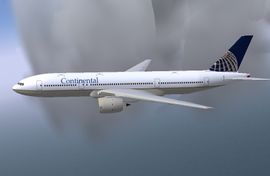
The Boeing 777-200 (772A) was the initial A-market model of the Boeing 777. The first customer delivery was to United Airlines in May 1995. It is available with a maximum take-off weight (MTOW) from 505,000 to 545,000 pounds (229 to 247 tonnes) and range capability between 3,780 and 5,235 nautical miles (7,000 to 9,695 km).
Boeing 777-200LR
The Boeing 777-200LR ("LR" for Longer Range), a variant of the Boeing 777, became the world's longest-range commercial airliner when it entered service in 2006. Boeing named this aircraft the Worldliner, highlighting its ability to connect almost any two airports in the world. It holds the world record for the longest nonstop flight by a commercial airliner, and has a maximum range of 9,380 nautical miles (17,370 km). The 777.200LR was intended for ultra-long-haul routes such as Los Angeles to Singapore.[1]
Boeing 777-300
The -300 features a 33.3 ft (10.1 m) fuselage stretch over the baseline -200, allowing seating for up to 550 passengers in a single class high-density configuration. The 777-300ER ("ER" for Extended Range) is the B-market version of the -300. It features raked and extended wingtips, a new main landing gear, reinforced nose gear, and extra fuel tanks.
Boeing 777-F
The 777 Freighter (777F) is an all-cargo version of the twinjet, and shares features with the -200LR; these include its airframe, engines, and fuel capacity. With a maximum payload of 226,000 lb (103,000 kg), cargo capacity is similar to the 243,000 lb (110,000 kg) of the 747-200F. The freighter has a range of 4,900 nmi (9,070 km) at maximum payload, although greater range is possible if less cargo weight is carried. As the aircraft promises improved operating economics compared to existing freighters, airlines have targeted the 777F as a replacement for older freighters including the 747-200F and MD-11F. The 777 for Flightgear is based on 777-200 developed by Justin Smithies, Syd Adams.
External links
- Boeing 777 aircraft systems simulator (not too relevant, X-Plane only support, last updated in 2007, AND: written in LISP!!!)
- Airline Pilots 777 forum Detailled info on procedures, manuals and documents
- Smart cockpît Boeing 777 manuals and procedures
- Flight manual
| |||||||||||
- ↑ Boeing 777 (Wikipedia)
